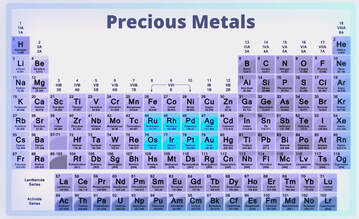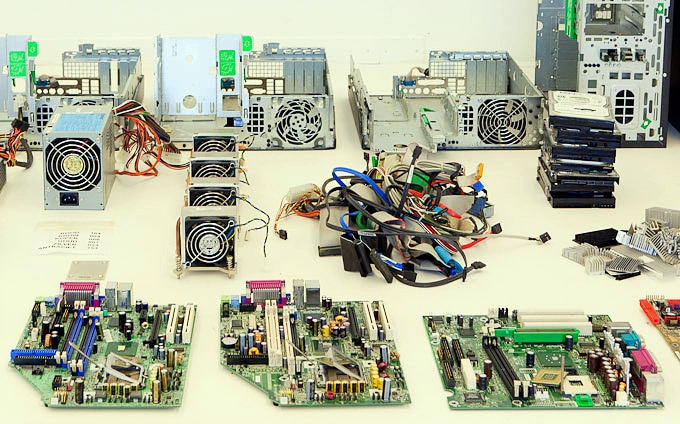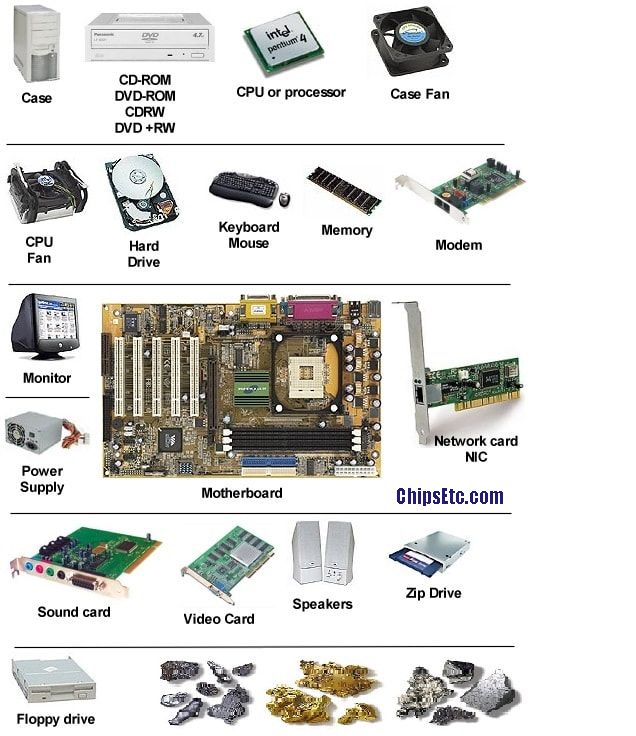Why is Gold used in Electronics?
Gold has been used in manufacturing electronic components because it offers good electrical conductivity, is a good conductior of heat, and most importantly Gold offers high resistance to corrosion and tarnishing.
Gold is relatively soft and mallable material that can be easily drawn into very thin wires and sheeting.
Gold is often used in medical devices that require high reliability because of its unique ability to resist corrosion and additionally because its a non-toxic metal.
Gold is used in equipment that goes into space, like manned spacecraft and satellites, due to it's ability to protect equipment and circuits against corrosion from ultraviolet light and x-ray radiation, as well as offering high reliability in electronic circuits.
Computers and electronic components designed for use in aerospace, defense, scientific / test, radar, and communications from 1960 to 1971 will typically have the highest amounts of gold used in them than todays comercial electronics. In a Department of Defense study for recycling surplus goverment equipment and for reducing precious metals use in governement systems, computers from 1976 were found to have contained four times as much gold in them as ones manufactured later in 1981. This reduction in the early 1980's was mainly due to the developemnt of smaller electronic components needing less gold per part.
More gold was used in electronics during this time period due to the need for corrosion resistance to maintain higher quality and reliability requirements, with the majority of components manufactured specifically to support the manned Space missions and national defense projects. Electronic circuit boards, connectors, and components during the 1960's often used generous amounts of gold plating with typical thicknesses in the range of 3 to 8μm, with some applications being as thick as 20μm. A micron (μm) is 0.001 of a millimeter.
Around 1971, the electronic industry pushed to start reducing the amount of gold plating required on connectors and other components due to the rapidly rising cost of gold. Also, the use of alternative precious metals for PCB contacts and connectors was explored, including Palladium and combinations of Gold / Paladium. Today, the thickness of gold plating required on some electronic components can be as low as 0.25μm.
Even today, most Computers & electronic devices have circuit boards and other components inside that still contain many types of precious metals including Gold, Palladium, Platinum and Silver.
In modern electronics, Silver is the most comonly used of all the precious metals, followed by gold, then Paladium, Platinum, Rodium and Ididium.
Computer components containing the most amounts of valuable precious metals include Motherboards, connector cards, video cards, memory cards, CPU & GPU chips, and other various small electronic components, connectors / cables, & Hard drives.
Which computer components have the highest precious metal content by weight:
- Computer CPU's (processors) - Gold / Silver / Palladium
- Memory (RAM) & Circuit Board Fingers / Connectors / Pins - Gold
- Circuit Boards (Motherboards) - Gold / Silver
- Hard Drives - Palladium / Platinum (on HD platters)
- Discrete Electronic components - Palladium / Silver (Capacitors)
- Whole Computers - Gold / Silver / Platinum / Palladium
List of Computer components with little or no precious metal value:
These eScrap (electronic scrap) items have the lowest recyclable value by weight. Unassembled, their weight is mostly composed of plastic or steel components, or glass weight in the case of monitor displays. Most recyclers will now actually charge you a fee per pound to accept Video monitors.
Their are a small amount of PCB cards and electronic compoenents inside that themselves will contain some precious metals, but the labor and time required to take the item apart and seperate the internal compoents is typically not worth the value of the gold or silver inside.
- CD/DVD drives
- Video Monitors
- Computer cases
- Keyboards / Mouse (the membrane inside often contains silver contacts)
- Printers
- Scanners
- Power Supplies
|
:
Where precious metals are used inside Computers:
|

List of Chemical Elements used in manufacturing Semiconductors, Computers & Electronics:
Silicon, Magnesium, Radium, Barium, Niobium, Osmium, Cobalt, Manganese, Titanium, Hafnium, Tungsten, Germanium, Gold, Silver, Copper, Mercury, Bismuth, Gallium, Zinc, Iron, Sulfur, Phosphorus, Cadmium, Palladium, Tantalum, Platinum, Aluminum, Carbon, Lead, Nickel, Boron, Chromium, Terbium, Potassium, Francium, Cesium, Sodium, Lithium, Indium, Calcium, Nitrogen, Oxygen , Cadmium, Arsenic, Chlorine, Helium, Neodymium, Selenium, & Tin.
Related: Gold content in CPU's and Computer Chips


